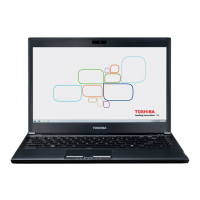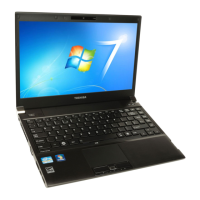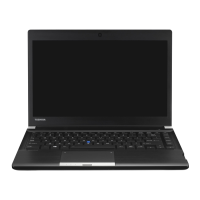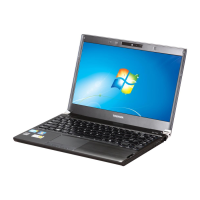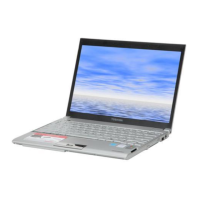
Do you have a question about the Toshiba R950 and is the answer not in the manual?
| Processor | Intel Core i5 or i7 |
|---|---|
| Storage | HDD or SSD |
| Display | 15.6-inch |
| Graphics | Intel HD Graphics |
| Operating System | Windows 7 or Windows 8 |
| Weight | Approx. 2.4 kg |
| Resolution | 1366x768 |
| Ports | USB 3.0, VGA, Ethernet |
| Wireless | Wi-Fi 802.11 a/b/g/n, Bluetooth |
| Battery Life | Up to 6 hours |
Explains formatting, abbreviations, icons, keys, and key operations.
Lists all hardware, documentation, and software provided with the computer.
Covers connecting AC adapter, opening display, turning power on/off, and initial setup.
Details computer components and indicators for the R950 model.
Details computer components and indicators for the R940 model.
Details computer components and indicators for the R930 model.
Describes the computer's internal hardware components like CPU and storage.
How to use the Touch Pad and AccuPoint for cursor control.
Information on keyboard layout, indicators, function keys, and FN key combinations.
How to enroll, use, and manage fingerprints for security and authentication.
Information on using DVD and Blu-ray drives, including formats and writing discs.
Setup and usage of Wi-Fi and Bluetooth.
How to connect to a Local Area Network.
Connecting and installing accessories like ExpressCards, Smart Cards, and memory media.
Guidelines for safe operation, moving, cleaning, and heat dispersal.
Describes various TOSHIBA utilities for system management and customization.
Unique and advanced features for computer convenience and performance.
Details on Sleep and Charge, power modes, and battery management.
Managing user/supervisor passwords and fingerprint authentication setup.
Program for configuring computer hardware settings and boot options.
Function to protect the hard disk drive from vibration and shocks.
Procedures for repairing or restoring the computer system.
Information on using multiple external displays with the computer.
How operating capability and battery status are affected by different power conditions.
Explains battery types, use, recharging, and handling.
Procedures and tips to maximize the computer's battery operating time and lifespan.
Describes the computer's different power states like Shut Down, Hibernation, and Sleep.
Systematic approach to diagnosing and resolving computer issues.
Simple checks for common problems before advanced troubleshooting.
Identifying issues by examining computer behavior, messages, and indicators.
Troubleshooting problems related to computer hardware components and peripherals.
Resolving issues with AC power, battery charging, and power indicators.
Resolving issues with Keyboard, Display, Hard Disk Drive, and Optical Disc Drive.
Resolving problems with LAN, Wireless LAN, and Bluetooth connectivity.
How to obtain technical assistance and support from TOSHIBA.
Details computer dimensions, operating temperature, and humidity requirements.
Specifications for the AC adapter and computer power input.
Pin configuration details for the external RGB monitor port.
Requirements for AC input plug compatibility and cord standards.
Lists certification agencies for power cords by country and region.
Covers legal footnotes for CPU, Memory, Battery Life, HDD, LCD, GPU, and Wireless LAN.
Notes on how copy protection standards affect media recording and viewing.
Details interoperability standards for Wireless LAN and Bluetooth devices.
Health considerations and radio regulatory information for wireless devices.
Compliance with FCC, IC, and European radio frequency regulations.
Important notices and indications for using equipment in Japan.
Information on technical conformity certifications and radio approvals.


